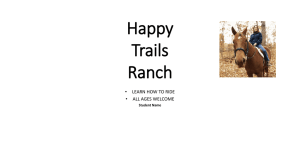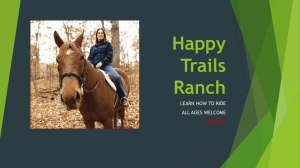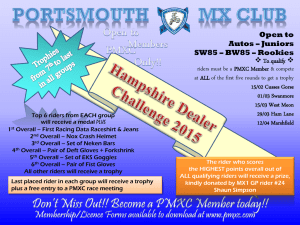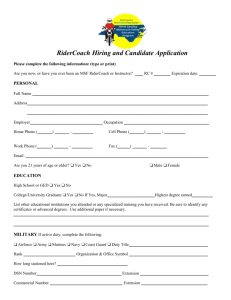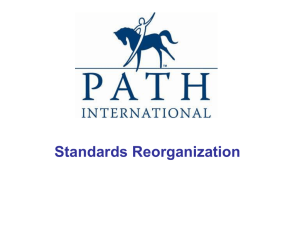2013 Annual Motorcycle Pre-Season Safety Brief
advertisement
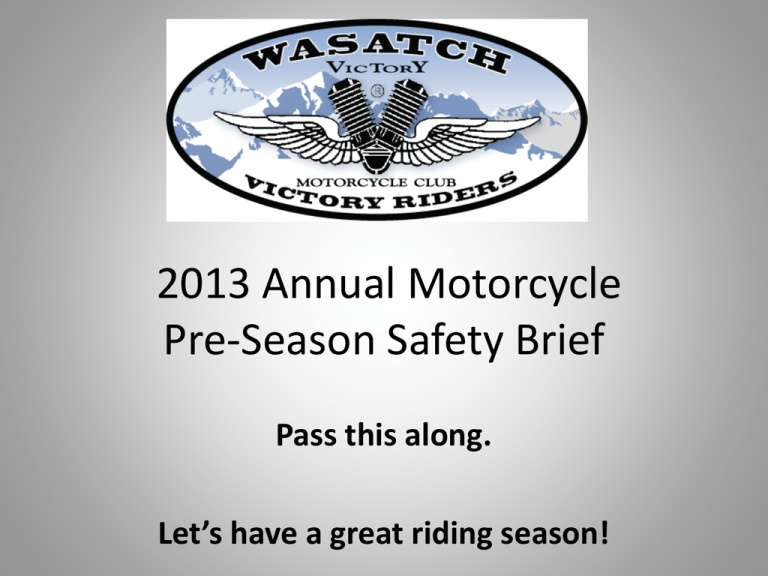
2013 Annual Motorcycle Pre-Season Safety Brief Pass this along. Let’s have a great riding season! Pre-Ride Inspection • Machine Safety • • • • • • • Headlights on (high beam during the day) Front mirrors (2) Bike in top-notch mechanical condition State safety inspection completed Tires serviceable Accessories secured Test emergency braking – – – – – – – T-CLOCS T - Tires & Wheels C - Controls L - Lights & Electrics O - Oil C - Chassis S - Stand MSF T-CLOCS Pre-Ride Inspection Checklist MSF T-CLOCS Pre-Ride Inspection Checklist MSF T-CLOCS Pre-Ride Inspection Checklist MSF T-CLOCS Pre-Ride Inspection Checklist MSF T-CLOCS Pre-Ride Inspection Checklist MSF T-CLOCS Pre-Ride Inspection Checklist Riding Skills • Proper Personal Protective Equipment – Helmet, Leathers, Eye protection, Sturdy Boots, Bright reflective colors at night. • Rider Training – Basic Rider Course (BRC) – Basic Rider Course2 (BRC2) (formerly ERC) • • For avid riders who have ridden a minimum of 2000 miles and are confident with their riding abilities – Refresher Training • Ride Like A Pro Riding Skills • Beginning of the season • Take a few short, low speed rides to refamiliarize yourself and to check out the bike’s handling • Avoid highly congested areas until you have a chance to freshen up your observation skills and riding skills Riding Skills • Practice Emergency Braking • Apply both brakes to near maximum, just short of locking them up. • You don’t want to lock the front brake. If the wheel does chirp, release the brake for a split second, then immediately reapply without locking it up • If your rear wheel locks up, do not release the brake. If your handlebars are straight, you will skid in a straight line, which is OK. • Keep the motorcycle upright and traveling in a straight line; and look where you’re going to be -- not where you are or where you’ve been. Weather/Local Conditions • • • • • • Weather (wet) Be most cautious when it first starts to rain Water and oil on roadways don’t mix Crosswalks and Stop Lines are very slippery Wet man hole covers are treacherous Cattle Guards – always cross perpendicular to rails Weather/Local Conditions • • • • Weather (hot/dry) Road (tar) Snakes Lots of loose dirt/rocks on road Hot wind Dehydration • • • • Weather (cold/damp) Frost, Ice, Snow Water on north faces leave ice fingers across road Hypothermia Local Conditions • Obstacles (Debris) – – – – – – Vehicles losing stuff Truck tires Glass Dead Animals Roadway concrete/asphalt Potholes • Best Defense with Obstacles and Debris – Distance – Space – Prudent Speed – Skilled in emergency maneuvers – Hand signals Local Conditions • Large Animals and You – They’re everywhere in Utah – Elk, Moose, Deer, Cattle, Horses, Sheep • Two Rules to Ensuring Your Safety – Slow down or stop before you reach the animal – If you can’t stop and the animal looks like it’s going to intercept you, speed up just as you are about to reach it. This will throw the impact timing off and hopefully avoid the impact. • Learn Emergency Maneuvers – Covered in the Basic Rider Course (BRC) and the Basic Rider Course2 (BRC2) Mishap Trends • • • • Most crash fatalities – Top 4 causes Excessive speed Fail to maintain situational (traffic) awareness Have inadequate or nonexistent formal training • Have very little riding experience Mishap Trends • • • • • Collision with another vehicle: 48.2% Front – 36.6% Lt Side – 3.5% Rt Side – 2.5% Rear – 3.6% Mishap Trends • Data from the NHTSA • 48% of all motorcycles involved in fatal crashes collided with another type of motor vehicle… • 25% of the motorcycles involved in fatal crashes collided with fixed objects… • In 42.6% of crashes the other vehicle was turning left while the motorcycle was going straight, passing, or overtaking the vehicle.… • 35% of all motorcycle riders involved in fatal crashes were speeding… Risk Management • Stick together – Safety in Numbers – Staggered twos, if group riding – 1 Second/2 Second Rule • Avoid riding at night – – – – Drowsiness Animal Danger Hard to See Debris Statistically Dangerous • Plan ahead – Road Conditions – Rest/Gas Stops Ride Captain Responsibilities • • • • • • • Somewhat responsible for the group’s safety Evaluate hazards for all riders in the group Increase Time/Distance requirements Watch out for road hazards Conduct a Pre-Ride Briefing Use of hand signals is extremely important Do a quick look at bikes in your group Ride Captain Pre-Ride Brief • • • • • • Hand signals Staggered riding 1 Second/2 Second Rule Riding the curves as a group Road hazards- Debris, Potholes, ANIMALS, etc…. Route description/Mileage/Ride Time/Rest, Fuel, and Food Stops. • Weather • Emergency Procedures To CONCLUDE…….. • • • • BE SAFE! Please Don’t Drink and Ride! Keep your motorcycle in top condition! Let’s Watch out for EACH OTHER!! • Let’s have a great 2013 for the Wasatch Victory Riders Motorcycle Club!
